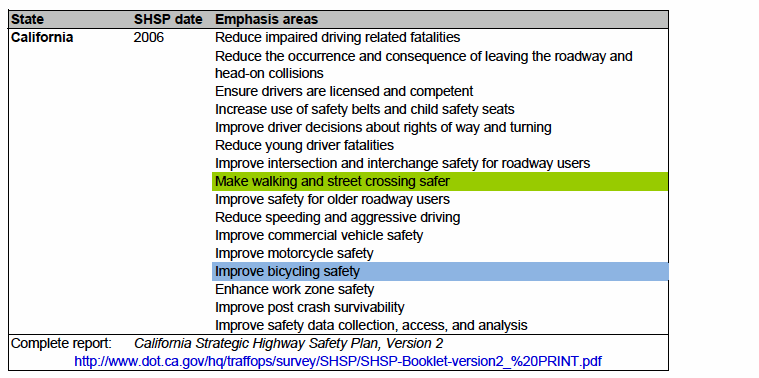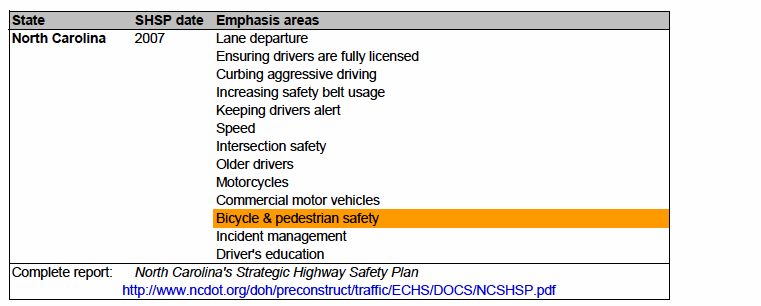ADVOCACY ADVANCE
Introduction
The Highway Safety Improvement Program (HSIP) was created under the 2006 transportation authorization law, SAFETEA‐LU, as one of the core Federal‐Aid funding sources. HSIP funds safety projects aimed at reducing traffic fatalities and serious injuries. Bike and pedestrian safety projects are eligible for HSIP funding. All public roads – including state, county and local roads – are eligible for HSIP funding. Examples of eligible projects include bike lanes, roadway shoulders, crosswalks, other intersection improvements and signage.
See the Advocacy Advance report on the HSIP for more information on eligibility, past spending, and program requirements. For safety programs that fund education see “Section 402 – State and Community Highway Safety Grant Program.”
States DOTs were slow to spend their available HSIP funds in the early years of the program, though they have been catching up in recent years. As of 2010, the 50 states spent 72 percent of the available total. Twenty‐one states transferred a combined $516 million to other highway programs. To date, bicycle and pedestrian projects have not received a fair share of HSIP funds. Fourteen percent of traffic fatalities nationwide in 2009 were non‐motorists. Yet, according to the Financial Management Information System (FMIS), only 6 states (CA, FL, NJ, OH, VA, WA) had HSIP funds coded as bicycle and/or pedestrian projects in 2010. Six states (AL, CA, FL, MN, NC, VA) coded HSIP funds on bicycle/pedestrian projects in 2009. (See appendix.)
This report examines some of the states that have successfully dedicated federal safety funds to reduce bicycle and pedestrian fatalities and crashes. In a number of cases, advocates have taken a leading role in ensuring the transportation agency had prioritized road safety projects for non‐motorists. Hopefully, these experiences will help advocates and officials in other states access this untapped resource for badly needed bicycle and pedestrian safety projects.
Summary of Recommendations
Although conditions and specific circumstances vary in different states, the advice from successful advocates and officials is remarkably consistent. The most important and frequent tips require advocates to find out the answers to the WHO, WHAT, WHEN, WHY, and HOWs of the HSIP process.
- Understand the HSIP planning process. Get acquainted with the program criteria, requirements, schedule and personnel. The following suggestions will help you do it.
- Cultivate internal advocates. Get to know your state’s HSIP staff. Find out who else influences the relevant policies, processes and project selection. They can include local agency staff, State Highway Safety Engineers, District Safety Engineers and others. These folks understand the system. They are important sources of information and can be your best allies – many of them care deeply about bicyclist and pedestrian safety.
- Cultivate elected officials. Elected officials wield influence over programs and priorities; when they show interest, it matters. They can also be more heavy‐handed. When agencies need a nudge, state legislation (or the threat of it) can produce results. The first step can be to highlight the need for safety interventions in your community. Find elected officials who care about this issue at the state and local levels. (Hint: they will care if they know their constituents care.)
- Influence the Strategic Highway Safety Plan (SHSP). In order for bicycle and pedestrian safety projects to be eligible for HSIP funds, the state’s Strategic Highway Safety Plan must identify them as priorities. Find out if bicyclist, pedestrian, and/or vulnerable road user safety is a plan priority area and get involved with revising the plan for bike/ped improvements and data collection. (See the matrix of SHSP priorities.) Plans have to be revised periodically. Find out when and recommend like‐minded officials and advocates for the relevant committees.
- Learn the project selection criteria. How does the state select and prioritize safety projects? What are the performance outcomes being measured? Figure out how bicycle and pedestrian projects can compete, before the selections are finalized, to influence the project selection and prioritization process.
- Collect crash and fatality data. The HSIP project selection process is data driven. For projects to be funded, they need to be shown to address to proven and quantifiable safety need. Gather this data and encourage the state to develop a better statewide reporting system and GIS mapping to make this data more available to local agencies.
- Announce the funding opportunity. If your HSIP proposal deadlines are public, share them with state and local advocates, your constituents and the public, and provide tips for what to emphasize in the application to make for a successful project. If not, find out and share other key deadlines, like for the Transportation Improvement Plans (TIP) and Strategic Highway Safety Plans (SHSP).
- Follow up. Meet with the department and elected officials after safety projects have been selected. Thank them for funded bicycle and pedestrian safety projects, and remind them of the continued need. Follow‐up with local communities that were funded for bicycle and pedestrian projects to ensure that they do a good job with the funding and that they evaluate the results. That way you can publicize how they got the funding and made the improvements to inspire other agencies to apply for HSIP funding for bicycle and pedestrian projects in the next round.
Download full version (PDF): Getting a Fair Share for Safety
About Advocacy Advance
www.advocacyadvance.org
“Advocacy Advance is a dynamic partnership of the Alliance for Biking & Walking and the League of American Bicyclists to boost local and state bicycle and pedestrian advocacy efforts. With support from SRAM, Advocacy Advance provides targeted trainings, reports, grants and assistance to equip advocates with the specific tools they need to increase biking and walking in their communities.”
Tags: Advocacy Advance, Alliance for Biking & Walking, Highway Safety Improvement Program, HSIP, League of American Bicyclists, Pedestrian









 RSS Feed
RSS Feed